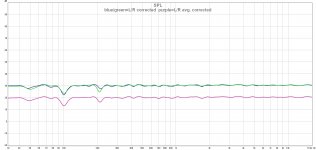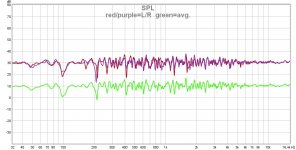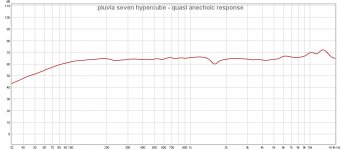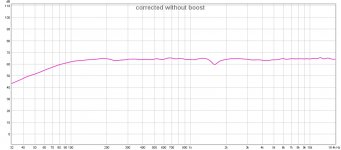Room anomaly from corner placement. The other side makes up for it with a slight boost.
(that's the stuff where a Sub could help me out so I don't have to use the other channel)
At 30 Hz you see more heavy lifting being done by the left channel. The right channel needs way more boost because it doesn't have that corner support. This way one channel makes up for the other's imbalance, so both use similar amount of boost as to not run out of digital headroom.
Here's the 6 cycle plot including the Left + Right sum

(that's the stuff where a Sub could help me out so I don't have to use the other channel)
At 30 Hz you see more heavy lifting being done by the left channel. The right channel needs way more boost because it doesn't have that corner support. This way one channel makes up for the other's imbalance, so both use similar amount of boost as to not run out of digital headroom.
Here's the 6 cycle plot including the Left + Right sum

Last edited:
Thanks Ron that was what I suspected was happening there. At least below about 100hz we do lose our ability to detect direction so the sum of the two channels does look very nice.
I'd use A+B to see if the phase lines up, it should be about 6 dB higher. Better would be to record it out in the room and just run a sweep running both speakers. That's what I do.
The predictions are always just that bit smoother than real life measurements.
Near field looks awesome though, I'm jealous. An advertisement for using DSP on a set of full range drivers in the near field if I ever saw one.
The predictions are always just that bit smoother than real life measurements.
Near field looks awesome though, I'm jealous. An advertisement for using DSP on a set of full range drivers in the near field if I ever saw one.
Last edited:
How does an unfiltered 500 ms response look, both L + R and it's sum? It should hold up pretty good I guess, even to 1/48 smoothing.
That would show the room entering the picture. Happening at a way lower level in the near field.
That would show the room entering the picture. Happening at a way lower level in the near field.
Near field looks awesome though, I'm jealous. An advertisement for using DSP on a set of full range drivers in the near field if I ever saw one.
Thanks. I'm very happy with it and will probably stop messing around for a while. I think this is the right recipe for my room. Though I may step up to some big 4"
speakers soon 😉. By the way, I've been listening with a linear phase LR HP filter (-6dB at 32 hz) which is not showing in my measurements. Anyway, as you can
probably gather from the SR/FR, and knowing that the reflections are about 22dB down (according to the IR in dB), it's a pretty accurate system. Mono recordings
sound small and centered/focused, while piano/choral/orchestral recordings have a soundstage size that is sometimes hard to believe. I think the symmetry and
diffraction properties of the speakers help with that also. Most importantly though, the timbre of instruments is correct.
Would I be right in thinking that an open baffle's impulse graph could not look as pretty as sealed or ported boxes?
I mean, there would be a lot of reflections from the open design, messing up the impulse, especially if the baffle was quite small, right?
I mean, there would be a lot of reflections from the open design, messing up the impulse, especially if the baffle was quite small, right?
That's not what the theory says. You know, the figure 8 pattern.
It will largely depend on where the speaker is placed. That energy coming from the back of the cone has to go somewhere. So it will probably bounce back at some time. If it creates strong peaky reflections it will cause comb filtering.
When I look at theoretical dipole behaviour I always get the feeling I'm looking at a comb filter pattern even without taking in account the reflections.
Diffraction will also come into play.
Here's a link showing some interesting examples. You see baffle shape does matter with dipoles, a true dipole would present 'comb filter like' pattern behaviour, the famous dipole peak being part of that.
Comb filtering is always associated with line arrays, I wonder why it's almost never mentioned in relation to dipoles. The baffle makes the difference, personally I don't think it's that good a compromise.
It will largely depend on where the speaker is placed. That energy coming from the back of the cone has to go somewhere. So it will probably bounce back at some time. If it creates strong peaky reflections it will cause comb filtering.
When I look at theoretical dipole behaviour I always get the feeling I'm looking at a comb filter pattern even without taking in account the reflections.
Diffraction will also come into play.
Here's a link showing some interesting examples. You see baffle shape does matter with dipoles, a true dipole would present 'comb filter like' pattern behaviour, the famous dipole peak being part of that.
Comb filtering is always associated with line arrays, I wonder why it's almost never mentioned in relation to dipoles. The baffle makes the difference, personally I don't think it's that good a compromise.
Ideally I used to think placing speakers on an infinite baffle was the best solution, like taking 2 adjacent rooms and hack holes in it for the drivers, the problem is: how does one toe in a wall? 😀
There should be a law on the internet that you can't use a black background, orange text letters and bright white graphics...
I'm starting to have a headache and I barely finished the first paragraph of that link!
I'm starting to have a headache and I barely finished the first paragraph of that link!
the problem is: how does one toe in a wall? 😀
With a hammer, a saw, and a divorce lawer.
With a hammer, a saw, and a divorce lawer.
Now, THAT is a good comment! 😀
This may be a basic question, but how do you run the .bat file scripts on a Mac? Can you just run them in the terminal window? It's been confusing to even find the files themselves given the OS X file system is a bit weird. (Hidden files, etc.)
I run everything in Wine
What do you run in wine to execute the scripts? Or is it as simple as "wine XXXX.bat"
I use DRCDesigner. I just copy the bat file to a preset I know I'll never use, then select that preset from the menu.
Anybody interested in a group buy of the ultimate Vifa/Peerless/Thympany driver TG9FD10-08 .
Price around $6 but there has to be many interested as minimum number of drivers for that price is >2000 pcs.
Price around $6 but there has to be many interested as minimum number of drivers for that price is >2000 pcs.
Here's a quasi-anechoic measurement (sort of ...quasi-quasi-anechoic?) of my Pluvia Seven Hypercubes (avg. of both speakers) using REW. A 3" measurement was merged with a (gated) 18" measurement at 3kHz (about 2.5 oct above predicted baffle step f3). The total response was windowed (FDW) at 1/12 octave. No dac or mic calibration was used.* I used this to run some filters with REW and I think they work very well (in conjunction with predicted baffle step compensation). One filter does not use any boosting and would be more like what could be done with a (complex) electrical speaker network. The other filter uses boosting and cutting to totally linearize the response (at the expense of a little digital gain reduction).
*I posted the same measurement in the Pluvia Seven thread with dac compensation used (my dac rolls off a bit in the top octave)
*I posted the same measurement in the Pluvia Seven thread with dac compensation used (my dac rolls off a bit in the top octave)
Attachments
- Home
- Loudspeakers
- Full Range
- A convolution based alternative to electrical loudspeaker correction networks




